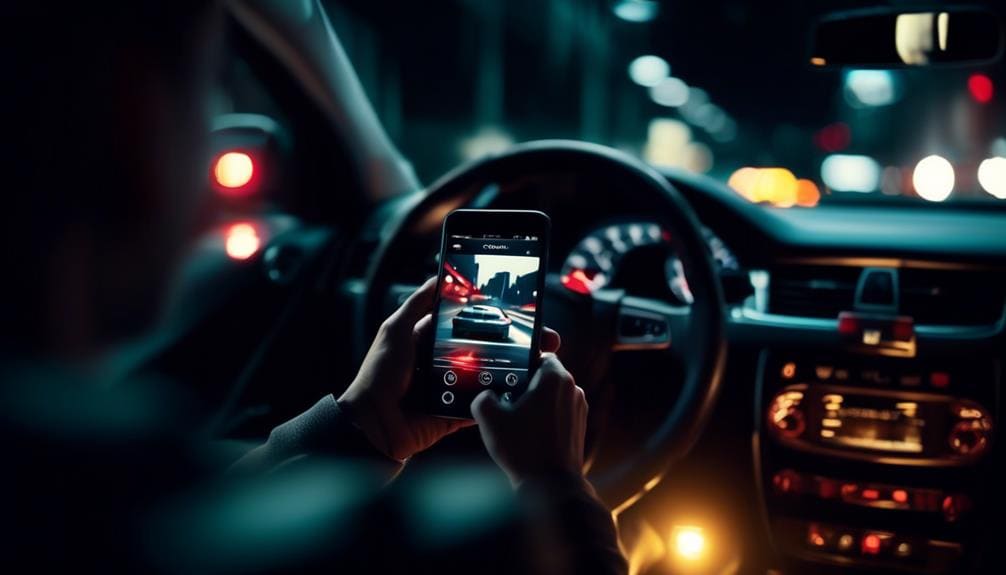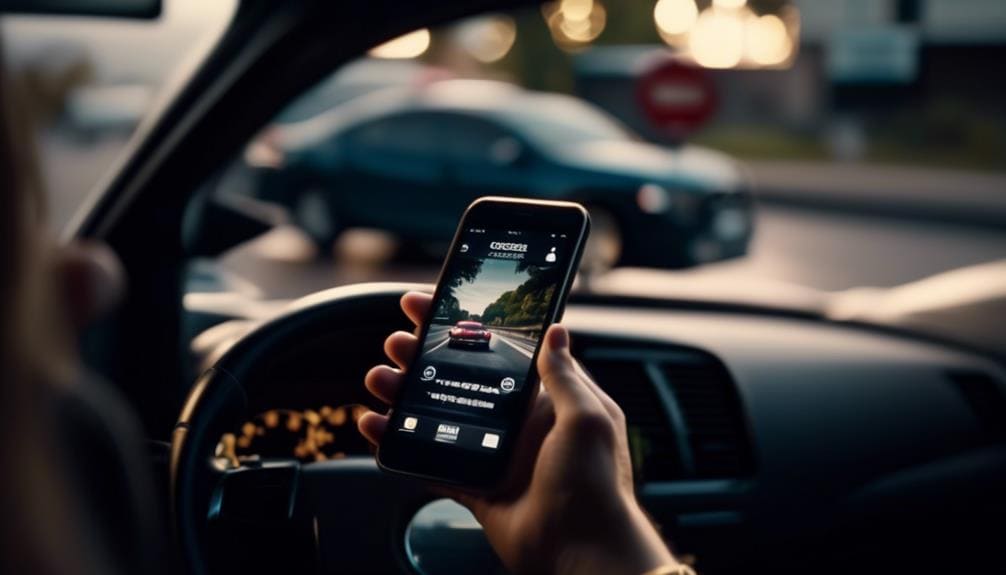
In the era of instantaneous digital communication, the insidious habit of texting while driving has emerged as a public health crisis with far-reaching implications.
Considerable research substantiates the notion that the brief diversion of a driver’s gaze from the roadway to a smartphone screen significantly elevates the risk of vehicular accidents, often with catastrophic outcomes.
Despite the proliferation of laws designed to dissuade this behavior, compliance is inconsistent, and the enforcement of such regulations presents ongoing challenges.
It is imperative that we address the complexities surrounding this issue, including the psychological underpinnings that drive individuals to prioritize connectivity over caution and the efficacy of current deterrents.
As we navigate the intersection of technology and traffic safety, the question beckons: What measures can be effectively implemented to disentangle the modern driver’s attention from the digital world, thereby safeguarding our streets and highways?
Key Takeaways
- Texting while driving is a significant cause of distracted driving and can lead to fatal accidents.
- Teenage drivers are particularly prone to texting while driving, influenced by their peers.
- Parental guidance and responsible driving habits can help prevent texting and driving among teenagers.
- Educators and employers have a crucial role to play in promoting safe driving practices and discouraging texting while driving.

Distracted Driving Explained
Texting while driving is a common yet dangerous distraction that significantly hampers a driver’s ability to respond appropriately to the road conditions. In 2021 alone, distracted driving, a serious issue on our roads, led to 3,522 fatalities, emphasizing the critical need to address this avoidable catastrophe.
Texting is particularly harmful as it demands a driver’s sight, manual control, and mental focus, which should be entirely devoted to driving tasks. Here’s how it works: when you’re texting, you’re visually engaged with your phone screen, manually tied up with typing, and mentally occupied with the content of your message. All of these take your attention away from the road and the vehicles or pedestrians around you.
The risks of using social media while driving are equally high. It’s easy to be fooled into thinking we can multitask effectively, but this is often not the case and can lead to disastrous consequences. To help combat these dangerous habits, technology solutions like app blockers and do-not-disturb features have been designed and are becoming more and more common in car systems.
Moreover, the psychological aspects of distracted driving, such as an inflated belief in one’s driving skills and a lack of understanding of the associated risks, can make the situation worse. It’s crucial for everyone involved—drivers, lawmakers, and car manufacturers—to work together to emphasize that driving requires our full, undivided attention.
Teenage Drivers and Texting
It’s no secret that texting while driving is a dangerous habit, particularly prevalent among teenage drivers. This practice significantly escalates the risk of road accidents, posing a serious threat not only to the driver but also to others on the road.
The role of peer influence is also crucial, with young drivers often feeling compelled to stay socially active, even while operating a vehicle. Tackling this pressing issue requires concerted efforts from parents, educators, and policymakers. Here’s how we can address this:
- Boost Safe Driving Awareness:
It’s important to shed light on the harsh realities of distracted driving through campaigns specifically aimed at teenagers. - Use Technology to Our Advantage:
There are numerous apps and devices that can restrict or completely shut off a phone’s functionality while driving. Encouraging their use could really help in curbing this issue. - Improve Driver Education Programs:
These programs should stress the severe consequences of texting and driving, making it a key part of the curriculum. - Use Peer Influence for Good:
Let’s develop peer-led initiatives that endorse safe driving habits among teenagers.
By combining education, technology, and supportive social structures, we can strive to ensure safer driving conditions for everyone.
Just remember, when you’re behind the wheel, your safety and the safety of others should always come first. So, let’s pledge to keep our eyes on the road, not on our phones!

Parental Guidance and Responsibility
‘Texting While Driving’ is a critical issue that needs addressing, especially among teenage drivers. Parents play a crucial role in this scenario – they can guide their kids and help them develop responsible driving habits.
Parents can make a significant difference by setting a good example. When parents demonstrate careful and distraction-free driving, their teenagers are more likely to do the same. This way, they can lay the foundation for safe driving habits.
Open and honest conversations about the risks and legal consequences of texting while driving can be beneficial. It helps teenagers understand the seriousness of the issue. A casual chat around the dinner table can be the perfect place to start these discussions.
Schools also play a pivotal role in spreading awareness about ‘Texting While Driving’. They can provide resources and host events to educate both students and parents. For instance, they can collaborate with local chapters of Students Against Destructive Decisions (SADD) to amplify the message and promote a culture of safe driving.
Teen driver education programs are another effective strategy. They include lessons about the dangers of texting and driving in their curriculum. This formal education can supplement the learnings from home and school.
Here is a quick overview of these strategies:
Remember, as parents of young drivers, you have a significant responsibility. You can shape their behavior and protect them from avoidable harm. It is not just beneficial, but crucial for you to be actively involved in their driving education.
Educator and Employer Initiatives
‘Texting While Driving’ is a significant issue that educators and employers are actively working on to combat. They play a crucial role in shaping behavior and attitudes towards this problem through various initiatives.
- Training Programs: Employers have started to include lessons on defensive driving and the hazards of texting while driving in their training programs. Simply put, these programs teach employees about the dangers of being distracted by their mobile devices while driving, and provide them with useful tips to avoid such distractions. The goal is to make employees more aware and careful when they are behind the wheel.
- Awareness Campaigns: Schools and workplaces are stepping up their efforts to make sure everyone knows about the deadly risks of texting and driving. They’re using posters, meetings, and online content to get their message across. The idea is to keep reminding everyone about the dangers until it becomes second nature to avoid texting while driving.
- School Policies: Schools are also doing their part by putting in place strict rules that discourage texting and driving. These policies make it clear what’s expected of students and underline how serious the problem is.
- Workplace Initiatives: In addition to training, employers are using other strategies to encourage safe driving. For example, they might offer rewards to employees who consistently drive safely. They might also use technology to prevent employees from using their phones while driving.

Legal Consequences and Laws
‘Texting While Driving’ is a prevalent issue with serious consequences, affecting road safety and human lives. To grasp the importance, we must understand what happens when a driver divides attention between the road and their phone.
Did you know that distracted driving contributes to a significant number of accidents? It’s true! In fact, the statistics are quite alarming. What’s more, most state laws have stepped in, imposing penalties ranging from fines to even license suspensions or jail time for severe offenses.
Now, you may be wondering what ‘distracted driving’ is. It’s when a driver engages in any activity that diverts attention from driving, like talking or texting on your phone, eating and drinking, or fiddling with the stereo or navigation system. Texting while driving is a form of distracted driving, and it’s a big no-no!
Awareness campaigns have been launched to spotlight the severity of these penalties and promote adherence to laws that forbid texting and other hand-held phone use while driving. If you’re a new driver, take note! In 37 states and the District of Columbia, there are stringent bans for novice drivers, highlighting the increased dangers associated with inexperience, technology, and distracted driving.
The enforcement of these laws is straightforward and rigorous. State and local police can issue citations that can lead to points on your driving record, making the consequences of distracted driving even more severe. But, it’s not just about escaping penalties – it’s about a commitment to preventing distracted driving and ensuring everyone’s safety on the road.
Conclusion
In conclusion, texting while driving constitutes a significant hazard that impairs driver focus and reaction times, thereby escalating the risk of vehicular accidents.
It is imperative that legislative frameworks, educational programs, and public awareness campaigns converge to combat this issue. Strengthening enforcement of existing laws, alongside cultivating a culture of responsibility among drivers, can mitigate this threat.
Collective action is crucial to safeguard lives and foster a safe driving environment for all road users.
Sources
NHTSA: Distracted Driving
FCC: Dangers of Texting While Driving
IIHS: Distracted Driving
The Zebra: Texting and Driving Statistics
Safewise: What Are the Dangers of Texting While Driving?
Mid-Columbia Insurance – Your Trusted Insurance Agent
Call our independent insurance agent professionals today at (509)783-5600 or click “Get a Quote” to request an insurance quote today. Get the insurance you want at a price you can afford!